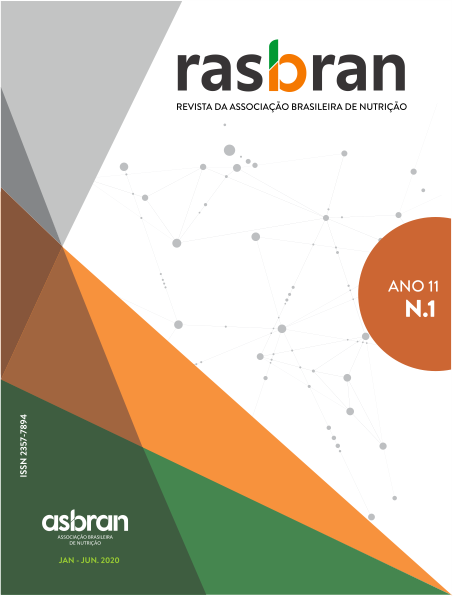Avaliação do efeito do psyllium (plantago ovata) nos sintomas de dor em portadores de fibromialgia
DOI:
https://doi.org/10.47320/rasbran.2020.912Abstract
Objective: Evaluation of the effect of psyllium (Plantago ovata) in pain symptoms in fibromyalgia carriers. Methods: The study included women with fibromyalgia (FM) enrolled in the waiting list of the Clinic School of Physical Therapy of Unisul. Data were collected from March to May 2017. The Visual Analog Scale (EVA) was used to assess the degree of pain, and the pain frequency was assessed through an objective question. Each patient received 300g of Psyllium to use 10g a day for thirty days. Data were expressed as mean and analyzed statically by analysis of variance (ANOVA). Results: A total of 33 FM patients were evaluated, ranging from 31 to 68 years. Before the intervention with psyllium the lowest number in the EVA was 5 (n = 1) and greater 10 (n = 3). After the use of psyllium the smallest number on the scale was 2 (n = 1) and the highest 10 (n = 2). Regarding the frequency ofpain, 75.75% (n = 25) of the patients reported having pain every day before the intervention and 51.51% (n = 17) after. The data from this study showed differences to improve the degree and frequency of pain, but were not statistically significant. Conclusion: Despite not having statistically significant values, it was possible to see improvement in the frequency and degree of pain in some patients.
Downloads
References
Ribeiro KL,Marinho ISF. Fibromialgia e Atividade Física. Fitness & Performance Journal,2005; 4:208-287.
Sociedade brasileira de reumatologia. Fibromialgia: cartilha para pacientes, 2011. Disponível em: <http://www.reumatologia.com.br/PDFs/Cartilha%20fibromialgia.pdf>. Acesso em: 20 de março de 2016.
Cole JA et al. Migraine, fibromyalgia, and depression among people with IBS: a prevalence study. BMC Gasstroenterol (London) 2006; 6(26):1-8.
Helfenstein Jr., M, Heymann R, Feldman D. Prevalência da Síndrome do Cólon Irritável em Pacientes com Fibromialgia. Ver Bras Reumatol, 2006;46(1):16-23
Assumpção A, Matsutani LA. Introdução à Fibromialgia. In: Marques, A P. Fibromialgia e fisioterapia: avaliação e tratamento.1 ed. Barueri: Manole, 2007. cap. 1, p. 1-13.
Sikander A, Rana SV, Prasad KK. Role of serotonin in gastrointestinal motility and irritable bowel syndrome. Clinica Chimica Acta, 2009; 403:47-55.
Bellato E, Marini E, Castoldi F, Barbasetti N, Mattei L, Bonasia DE, et al. Fibromyalgia syndrome: etiology, pathogenesis, diagnosis, and treatment. Pain Res Treat. 2012; 2012:426130
Brioschi EFC, Brioschi ML, Yeng LT, Teixeira MJ. Nutrição funcional no paciente com dor crônica. Rev. Dor (São Paulo), 2009; 10(3):276-285.
Passos LML, Park YK. Frutooligossacarídeos: implicações na saúde humana e utilização em alimentos. Cienc Rural. 2003;33:385-90
Jenkins DJ, Kendall CWC, Augustin LSA, Franceschi S, Hamidi MA. Effect of psyllium in hypercholesterolemia attwomonounsaturatedfattyacidintakes. Am J Clin Nutr.,1997; 65:1524–1533.
Rideout TC, Harding SV, Jones PJH, Fan MZ. Guar gum and similar soluble fibers in the regulation of cholesterol metabolism: Current understandings and future research priorities. Vascular Health and Risk Management 2008;4:1023–33.
Zandonadi R, Botelho R, Araújo WC. Psyllium como substituto do glúten. Nutrire,2005; 30:362-362.
Marlett, J. & Fischer, M. The active fraction of psyllium seed husk. The Proceeding of the Nutrition Society, 2003; 62(1), 207-209.
Jiang H, Ling Z, Zhang Y, Mao H, Ma Z, Yin Y et al. Altered fecal microbiota composition in patients with major depressive disorder. Brain, Behavior, and Immunity, 2015; 48:186–194.
Matsuda JB, Barbosa FR, Morel LJ, França SDEC, Zingaretti SM, da Silva LM et al. Serotonin receptor (5-HT 2A) and catecholO-methyltransferase (COMT) gene polymorphisms: triggers of fibromyalgia? Rev Bras Reumatol 2010;50(2):141-9.
Batistuzzo JAO, Itaya M, Eto Y. Formulário Médico-Farmacêutico. Pharmabooks, 2006; 3:670.
Salas-salvado J, Farre´s X, Luque X. Effect of two doses of a mixture of soluble fibres on body weight and metabolic variables in overweight or obese patients: a randomised trial. British Journal of Nutrition, 2008; 99:1380–1387.
Solà R, Bruckert E, Valls RM, Narejos S, Luque X, Castro-Cabezas M et al. Soluble fibre (Plantago ovata husk) reduces plasma low-density lipoprotein (LDL) colesterol, triglycerides, insulin, oxidised LDL and systolic blood pressure in hypercholesterolaemic patients: a randomised trial. Atherosclerosis. 2010; 211(2): 630-7.
Gostner A. et al. Effect of isomalt consumption on faecal microflora and colonic metabolism in healthy volunteers. Br J Nutr,2006;95:40–50.
Mcrorie JW. et al. Psyllium is superior todocusatesodium for treatment of chronic constipation. Aliment PharmacolTher,1998; 12(5): 491-497.
Kelly G. Inulin-typeprebiotics – a review. Part 1. Alternative Medicine Review, 2008; 13(4):315-329.
Roberfroid MB. Inulin-typefructans: functional food ingredients. London: CRC Press, 2005; 392.
Kolida S, Meyer D, Gibson GR. A double-blind placebo – controlled study to establish the bifidogenic dose of inulin in healthy humans. European Journal of Clinical Nutrition, 2007; 61(10):1189-1195.
Hawrelak JÁ, Myers SP. The causes of intestinal dysbiosis: a review. Altern. Med. R., Sandpoint,2004; 9(2):180-197.
Downloads
Published
How to Cite
Issue
Section
License
A Revista se reserva no direito de efetuar, se necessário, alterações de ordem normativa, ortográfica e gramatical, com vistas a manter o padrão culto da língua, respeitando, porém, o estilo dos autores.
Ao encaminhar os originais, os autores cedem os direitos de primeira publicação para a Revista da Associação Brasileira de Nutrição e aceitam que seu trabalho seja publicado de acordo com nossa Declaração de Direito Autoral.
Os documentos publicados serão atribuídos a licença 
Este trabalho está licenciado com uma Licença Creative Commons - Atribuição 4.0 Internacional.


